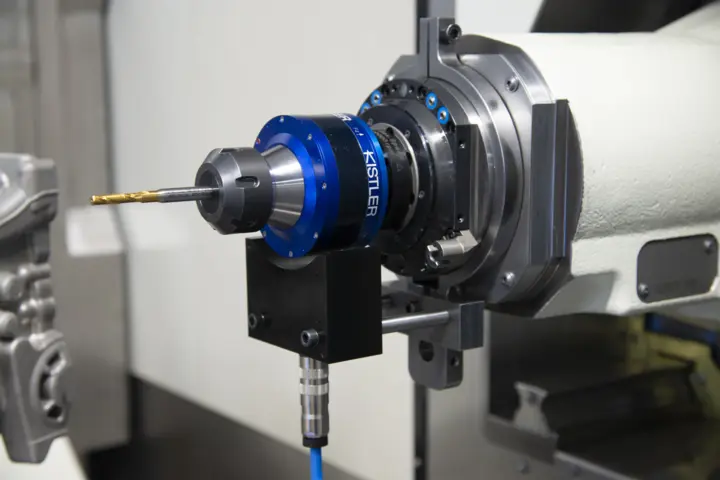Process optimization underpinned by accurate measurement results
Julian Raum began his career as a trainee at EMUGE-FRANKEN in 2006. After further training and studies, he is now a mechanical engineer in the Application Technology and Development department at the EMUGE plant. As a member of a 45-strong team, his responsibilities include measurement technology, data analysis and test test evaluation. He also programs user algorithms in high-level languages such as MatLab. This is how he describes the challenges he faces in his day-to-day work: 'Our customers are accustomed to receiving very high quality from us; they expect us to be able to deliver – and to do so on time. They often require savings on tool costs, and one way to achieve that goal is to extend tool lifetimes.' Teichgräber adds: 'Customers also appreciate our wide-ranging product portfolio as well as our ability to develop special tools and innovative market-ready processes.'
To attain these objectives and consolidate its leading position, EMUGE-FRANKEN has put its trust in measurement technology from Kistler since 1998. 'We currently operate three Kistler products in our development department: one force/torque sensor and two dynamometers. These include the 9170A 4-component dynamometer that rotates in the spindle, so we can measure torque as well as the forces along the three spatial axes,' Raum explains. The developers at EMUGE-FRANKEN use the measuring instruments from Kistler in bench tests aimed at optimizing tools and processes: the results play a crucial part in achieving the desired quality. 'Rather than relying on subjective assessment criteria such as noise development, vibrations and visual impressions, we've been taking more measurements on our products since about 2014,' Raum continues. 'The sensors give us dependable quantitative feedback that allows us to make far better comparisons between tools, and we can vary the individual parameters to implement all-round process optimization.'
Pushing the limits of what is feasible
This approach also opens the way to innovations that regularly meet with an enthusiastic response from customers and industry experts. One outstanding example is EMUGE-FRANKEN's Punch Tap: based on a special tool and innovative kinematics, threads such as those in engine cylinder heads are no longer tapped, formed or milled – instead, they are literally 'punched in' with Punch Tap. Helical (or spiral) cold-forming of threads is a production process that saves as much as 75 percent of the time taken by conventional technologies, with no compromises on quality. 'Punch Tap was developed jointly with a major OEM in the automotive sector. We had to validate the processes directly on the customer's production line, and that was when knew we could count on measurement technology from Kistler,' Raum recalls. 'Their sensors and dynamometers help us to understand how changes to the tool's macrogeometry and microgeometry impact the process force and torque, and they also give us better insights into the kinematics in the machining process.'
In what other ways do solutions from Kistler benefit the ongoing development of geometries, coatings and kinematics at EMUGE-FRANKEN? 'Thanks to piezoelectric technology from Kistler, we can take dynamic measurements with high sampling rates. Because the piezo system is rigid, it has a high natural frequency and does not become deformed – unlike a strain gauge sensor,' Raum continues. 'These measuring systems operate very stably, and they deliver highly accurate measurements. We are also extremely satisfied with the support we received from Kistler during and after the practical testing at FRANKEN in Rückersdorf. The high quality of Kistler products speaks for itself: we began operating the very first dynamometer at EMUGE in 1998 – and it was only taken out of service in 2019! Their measuring equipment is very robust, and it can also withstand tool breakages in most cases.'
Measure, analyze and understand – with Kistler
EMUGE‑FRANKEN's tool development department is very well equipped at present, with the 9345B force/torque sensor, the 9257B 3-component stationary dynamometer and the 9170A rotating 4-component dynamometer (RCD). What does the future hold for the machining industry, and what impetus do customers expect from Kistler? Jörg Teichgräber answers first: 'We're seeing an overall reduction in machining tasks on account of the transition to electromobility. That's why EMUGE‑FRANKEN is looking to tap new markets. Digitalization and Industry 4.0 are also key factors – advances in both areas are opening up new opportunities not only networking with our customers, but also for intelligent tools. For example, we're integrating an NFC (Near Field Communication) chip into a tool holder to provide service recommendations to users depending on the particular application. And as we continue to develop our tools, we shall also continue to put our trust in our working relationship with Kistler.'
Development engineer Julian Raum could also envision deploying accelerometers from Kistler for on-site process optimization at customers' premises in the future. For example, this would make it possible to test milling processes with different cutting parameters, and the vibration behavior of the entire system could be assessed. 'Wireless data transmission is another feature that would be of interest to us. A measuring chain that does the job without cables would deliver a whole series of practical benefits.'






![Tapping into success [object Object]](https://kistler.cdn.celum.cloud/SAPCommerce_Document_Preview/961-474e.webp)